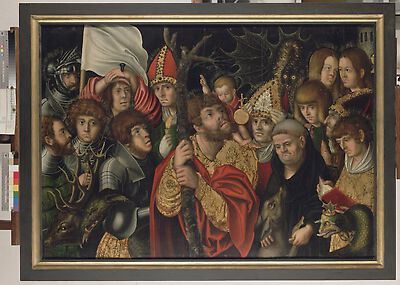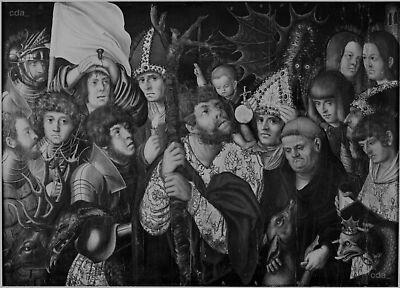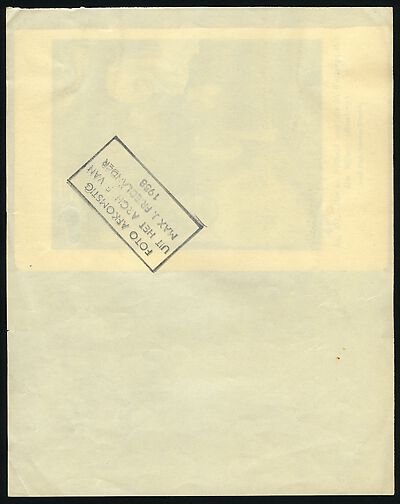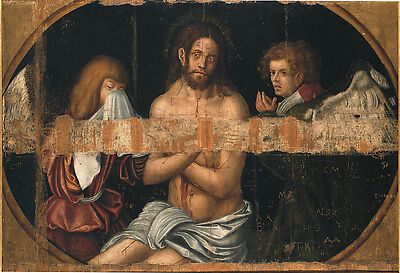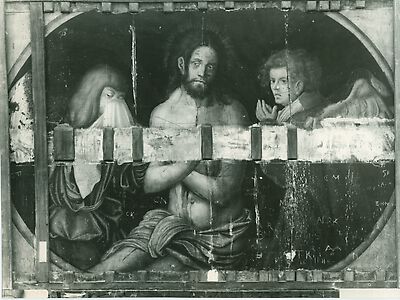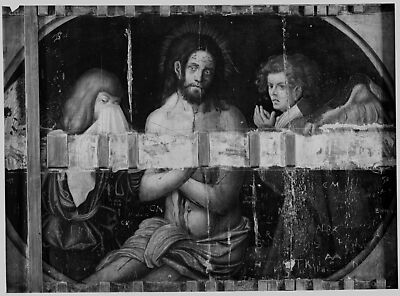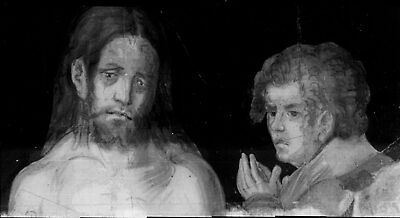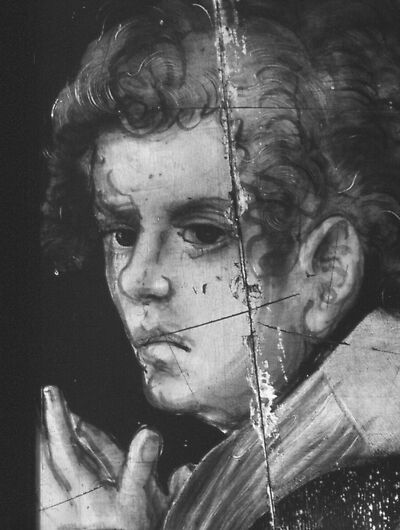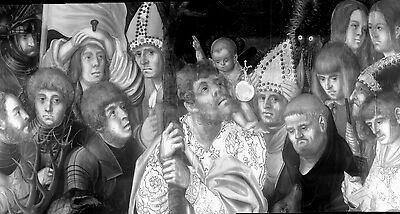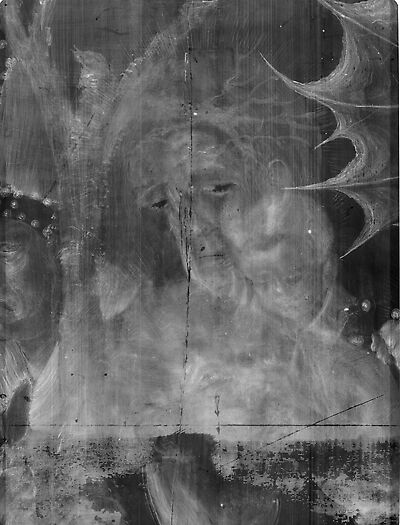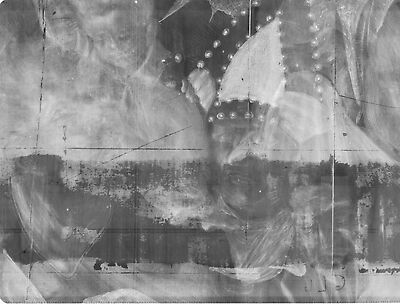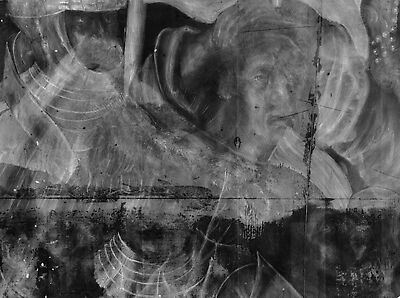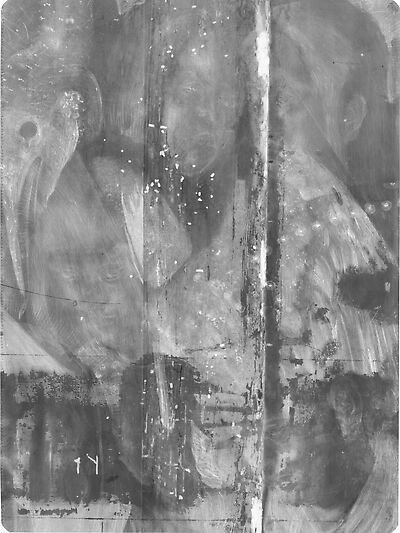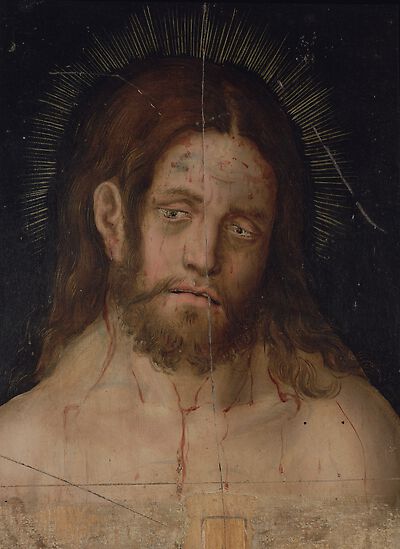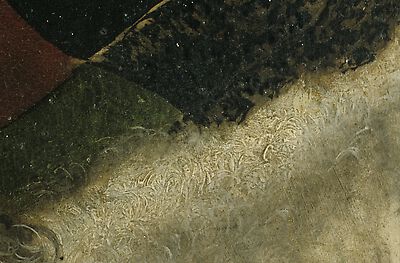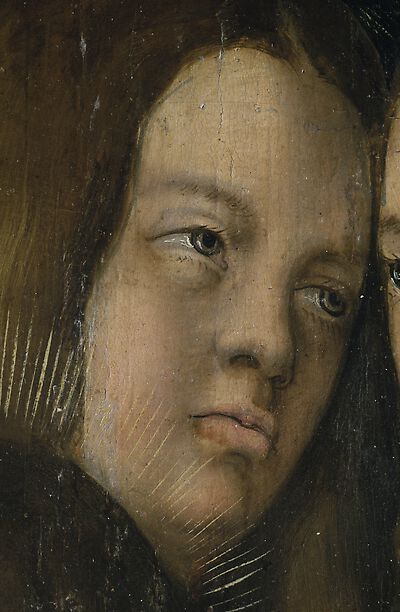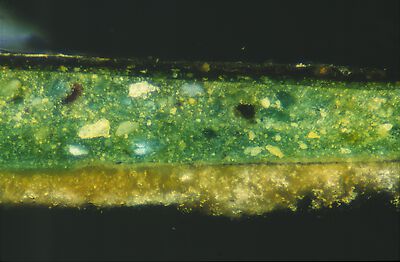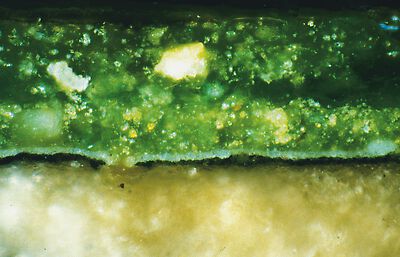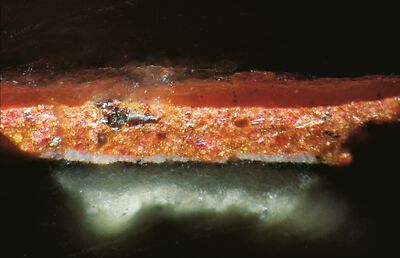Analysis of cross-sections; Incident light microscopy; UV fluorescence; Staining tests; SEM/EDX:
Probenliste Heydenreich [38]
Object No.: FR 016
Cross-section No.: EP 001
Brief description of paint: flesh paint, Christ's arm
Sample location: Reverse, flesh paint of Christ, right arm, bottom edge of the large loss, centre
Sample No.: 001
Incident light microscopy: yes
Incident light microscopy, photograph: 2 slides
UV fluorescence:
UV fluorescence photograph:
Staining test for protein:
Staining test for protein, photograph:
Staining test for oil:
Staining test for oil, photograph:
SEM/EDX: yes
SEM/EDX photograph:
Observations:
2. brownish transparent layer [Ca!! O - Pb - C - Al - Mg -] not easy to differentiate, the thickness of the layer is unclear
1. the flesh paint is almost white [Pb!! Ca C - O- Al-] with glassy transparent and glassy yellowish inclusions; pigment particles [Si!! Ca! C! Pb O] there may be a red and blue pigment particle in the centre
0. the ground is missing
Commentary: The flesh paint appears homogenous and as a single layer it is very pale, containing only a small addition of coloured pigment (blue, red). A proportion of the glassy, partially more yellowish-brown inclusions contains more silicon, calcium and noticeably more carbon (indicating that they are particles of grit) than in other areas. These inclusions only contain small amounts of calcium, therefore it is unlikely that they can be identified with the brownish discoloured lake pigments, which are found elsewhere, as these contain greater quantities of chalk (substrate). Silicon is also the principal component of the brown glaze over the flesh paint on the Princes' Altar.
Examination carried out by: EDX Frau Chistalle, Forschungszentrum Rossendorf, Heydenreich
Probenliste Heydenreich [39]
Object No.: FR 016
Cross-section No.: EP 002
Brief description of paint: green robe of the angel, pale fold
Sample location: Reverse, robe of the angel on the right, at the bottom edge
Sample No.: 002
Incident light microscopy: yes
Incident light microscopy, photograph: yes
UV fluorescence:
UV fluorescence photograph:
Staining test protein:
Staining test protein, photograph:
Staining test oil:
Staining test oil, photograph:
SEM/EDX:
SEM/EDX photograph:
Observations:
4. dark brown transparent layer; varnish?
3. green layer with green, yellow white and brownish glassy pigments (an application of at least three layers, which are relatively similar in appearance); green paint from the robe; thickness c. 0.047 mm
2. thin white layer with one black pigment particle; imprimitura; thickness c. 0.008 mm
1. very thin, partially visible black layer; underdrawing
0. white layer; ground, which is increasingly transparent with a yellowish discolouring towards the top
Commentary: There may be an isolating layer over the ground, then a black underdrawing and a very thin white imprimatura. The green paint consists of at least three layers of admixtures of green, yellow, white and brownish glassy pigments.
Probenliste Heydenreich [40]
Object No.: FR 016
Cross-section No.: EP 003
Brief description of paint: green robe of the angel, dark fold
Sample location: Reverse, angel on the right, green robe, dark fold, at the bottom edge of the panel
Sample No.: 003
Incident light microscopy: yes
Incident light microscopy, photograph: yes, Schramm
UV fluorescence: yes
UV fluorescence photograph: yes, no slide
Staining test protein:
Staining test protein, photograph:
Staining test oil:
Staining test oil, photograph:
SEM/EDX: green is suitable for further analysis
SEM/EDX photograph:
Observations:
7. above black-brownish layer (slight fluorescence) can not be readily differentiated, varnish
6. a further intense green layer
5. very thin dark green-grey intermediate layer with a lot more black pigment, less green; shadow
4. grainy dark green layer (one or two ?) with green, white, single reddish brown and black pigments, no fluorescence, single green-blue pigments
3. green-white layer with bluish green and white pigments; light green undermodelling
2. very thin white layer, partially white-green without a clear separation from layer 3, minimal fluorescene, presumably imprimatura
1. very thin black layer, not continuous; underdrawing
0. white layer with a less glassy surface; ground; fluorescence increasing towards the top
Commentary: The underdrawing is only partially visible as a layer, above this is the imprimatura. The undermodelling of the robe is executed in light green although this is a sample from the shadow of the fold. The green paint was applied in a number of layers (at least 5) dark green with a proportion of green, black and white pigment. On the surface there is a thin fluorescing isolating layer and a thicker coating layer.
Probenliste Heydenreich [42]
Object No.: FR 016
Cross-section No.: EP 005
Brief description of paint: white handkerchief
Sample location: Reverse, angel on the left, white handkerchief, lighter side, bottom edge of the loss
Sample No.: 005
Incident light microscopy: yes (Schramm)
Incident light microscopy, photograph: yes (Schramm), slide
UV fluorescence: yes
UV fluorescence photograph: yes (Schramm)
Observations:
1. pale grey layer (white, black and blue pigments)
0. white ground
Commentary: no grey undermodelling, PIXE-analysis was carried out in this area [Pb!, Cu!, C!, Ca, K, Fe, Mn, Ti, Sr], Interpretation: 'lead white on (ivory)black [?] containing azurite" is doubtful
Probenliste Heydenreich [43]
Object No.: FR 016
Cross-section No.: EP 006
Brief description of paint: red robe of the angel
Sample location: Reverse, angel on the left, red robe, bottom edge of the large loss
Sample No.: 006
Incident light microscopy: yes
Incident light microscopy, photograph: yes
UV fluorescence: yes
UV fluorescence photograph: yes
Observations:
3. Varnish
2. light red layer, white and intensive red, lake-like pigments, the red particles appear red to orange-red in UV
1. white mprimitura
0. white ground
Commentary: The red lake should be analysed further
Probenliste Heydenreich [47]
Object No.: FR 016
Cross-section No.: EP 010
Brief description of paint: flesh paint of Christ with traces of red blood
Sample location: Reverse, flesh paint of Christ, from the stomach with traces of blood, bottom edge missing
Sample No.: 010
Incident light microscopy: yes
Incident light microscopy, photograph: yes (Schramm), no slide, partially coated
UV fluorescence: yes
UV fluorescence, photograph: yes (Schramm)
SEM/EDX: yes, Rossendorf, Fr. Chistalle, DSM 962 (Zeiss)
Observations:
3. indifferent varnish layer
2. red layer [Al, S, Ca, Pb] in the red particles [Al!, Pb!?, (S)] - traces of blood
1. white layer - lead white [Pb!, Al, Ca] with glassy inclusions, thes appear to contain lighter elements in SEM [Pb (S also possible)!!, Al!, K!,] - Flesh paint, the glassy inclusions only differ in a slightly higher concentration of Al and as such are not the same as in EP 001
0. white ground [Ca!, (Pb), at the bottom only Ca!] - could indicate a drying oil?
Commentary:
- the glassy inclusions in the flesh paint are not yet understood, further examination would be useful
- the componenents of the red lake are not yet clear: the particles appear darker than less heavy elements in SEM whereas as the surrounding material is lighter, in other words a heavier material, which may result from a medium containing lead (siccative?). In one particle there appears to be a higher sulphur content? - Interaction with lead? otherwise lead , aluminium and calcium are represented in the particles (substrate?). In comparison there appears to be considerably more aluminium in the sample from St Chrisopher's robe.
- PIXE-analysis also detected Sn, so lead tin yellow was presumably also employed?
Probenliste Heydenreich [48]
Object No.: FR 016
Cross-section No.: EP 011
Brief description of paint: flesh paint of Christ, thigh
Sample location: Reverse , flesh paint of Christ, proper right thigh, centre, bottom edge of painting
Sample No.: 011
Incident light microscopy: yes
Incident light microscopy, photograph: yes
UV fluorescence: yes
UV fluorescence photograph: no
Observations:
1. pale flesh paint, white and very fine red pigment (vermillion?), single black pigments
2. white ground
Commentary: single layer of pale flesh paint without further differentiation
Probenliste Heydenreich [54]
Object No.: FR 016
Cross-section No.: EP 083
Brief description of paint: red robe of angel
Sample location: reverse, red robe of angel, bottom edge of the loss, to the right of the cloth
Sample No.: 147
Incident light photograph: yes
SEM/EDX: yes (Rossendorf)
Observations:
4. red layer [Ca!, C, Mg, Pb] here a different red lake was employed to that of below, warm in tone
3. red layer [Al!, Pb!, Ca] red lake (orange fluorescence) with lead white - modelling
2. pink layer [Pb!, Al!, Ca, Si] lead white with red lake pigment - undemodelling
1. black underdrawing
0. white ground
Commentary:
- further examination of the two red lake pigments would be useful
Probenliste Heydenreich [55]
Object No.: FR 016
Cross-section No.: EP 084
Brief description of paint: black background
Sample location: reverse, black backgound between Christ and the angel on the left, next to the letter 'K'
Sample No.: 148
Methods of analysis: partial vapour phase deposition
SEM/EDX: yes (Rossendorf)
SEM/EDX photograph: no
Observations:
4. varnish
3. black layer (only visble as a discrete layer, separate from layer 2 with the SEM) Spot [C!!, Ca!, S], suface [C!, Ca, Pb, Si, (Cu)]
2. black layer [C!!, Pb, Ca, Cu]
1. thin white layer -imprimatura
0. white ground
Commentary:
- Phosphorous was not detected, indicating that it is a bone black, the surface appeared vey homogenous in the SEM image, too homogenous for bone black, lumps of chalk were however not visble in the cross-section or the SEM image (see surface examination), where does the calcium come from? It may be a lamp black with the addition of lime or chalk and a lead siccative, a red lake on a Ca substrate is also possible? - the copper is probably from copper green rather than azurite
Probenliste Heydenreich [58]
Object No.: FR 016
Cross-section No.: EP 085
Brief descriptioin of paint: gilding with red glaze
Sample location: reverse, top left spandrel, top edge, gilding with red glazed stripe
Sample No.: 151
Methods of analysis: partial vapour phase deposition
Incident light microscopy photograph: yes Ob 16
SEM/EDX: yes (Rossendorf)
Observations:
4. transparent reddish brown, relatively dark layer [Ca!, Pb, Si, Ca, Cu, Al], calcium in the coating, also detected in PIXE-analysis - challk in oil as a coating, or was this a warm red glaze?, Ca does not appear as particles
3. Goldleaf [Au, (Ag), (Cu)], thickness 500nm (measured under a magnification of 10000x)
2. yellowish layer with single red pigments (PIXE: vemillion), white and black, EDX: [Pb!!, Ca, Sn, Cu, Fe] - mordant with lead tin yellow, or lead white and other pigments, eg. vermillion
1. thin white layer - lead white imprimatura
0. white ground
Commentary:
- if the coating contained a warm red lake pigment witha a Ca substrate, then the tonal harmonies within the painting have been considerably altered
Probenliste Heydenreich [59]
Object No.: FR 016
Cross-section No.: EP 086
Brief description of paint: yellow-orange lining of the robe
Sample location: reverse, angel on the left, orange lining, top edge of the loss
Sample No.: 152
Methods of analysis: partial vapour phase deposition
SEM/EDX: yes (Rossendorf)
Observations:
2. red layer [Pb!, Ca, Sn, Fe, (Al)] - red iron oxide and ed lead?, lead tin yellow
1. white layer [Ca]
Commentary:
- comparative measurements with PIXE-analysis detected Fe und Sn (red iron oxide and lead tin yellow)
The following pigments were identified on the panel in Torgau:
- lead white
- lead tin yellow
- vermillion
- carbon black (lamp black?)
- red lake (Al, with orange fluorescence in UV)
- red lake (Ca, without orange fluorescence in UV)
- copper green
- green glaze on the basis of copper green
- red iron oxide
- red lead
- brown glaze
- azurite
- chalk
[Heydenreich 1995, unpublished examination report]

